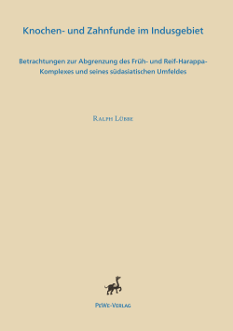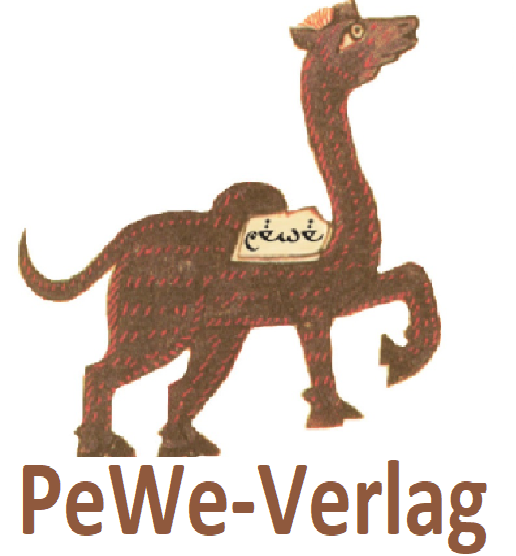
Ralph Lübbe
Knochen- und Zahnfunde im Indusgebiet.
Betrachtungen zur Abgrenzung des Früh- und Reif-Harappa-Komplexes und seines südasiatischen Umfeldes.
Format: 29 x 21 cm — Softcover
Umfang: 122 Seiten, mit 70 Abbildungen
ISBN: 978-3-935012-23-2
Preis: 19,80 €
© PeWe-Verlag 2017
Die neolithisch-chalkolithische und bronzezeitliche Industalkultur gehört zu den frühesten städtischen Hochkulturen. Ihre flächenmäßige Ausdehnung übertraf die des alten Ägypten und Mesopotamiens zusammen. Die größten Städte hatten Abstände von bis zu 200 km voneinander, während es in Mesopotamien oft nur 20 km waren.
Die frühen Phasen werden meist mit den sumerischen und akkadischen Kulturen verglichen, so dass die Erforschung fachlich nicht der Indologie, sondern der Vorderasiatischen Archäologie zugeordnet wird.
Wurden Schrift und Materielle Kultur bisher vorrangig bewertet, so erlaubt eine humanbiologisch-anthropologische Betrachtung neue Erkenntnisse. Eine Vielfalt ausgegrabener Knochen und Zähne sind ein weiteres, weniger bekanntes Markenzeichen der dritten Hochkultur der „Alten Zeit“, am Indus. Die Untersuchungen erlauben Einblicke in Konstanz und Brüche zivilisatorischer Entwicklung.
Die Osteologie als Untersuchung von Knochen und Zähnen erlaubt Lebensweise, Essgewohnheiten, Nahrungszubereitung, Hygiene, Identität und Lebensstandard darzustellen. Für die Epidemiologie interessante Störungsbilder werden geschildert. Die Verwendung genetisch-molekularbiologischer Hilfsmittel ist erst am Anfang. Beispielhafte Krankheitsbilder und erkennbare Kausalitäten lassen Geschehens-Abläufe und soziobiologische Zusammenhänge erklären.
Linguistische Beobachtungen können Populationssprünge nicht erklären. Erklärungen tradierter Ereignisse (Ariersturm, Rigveda) mit Hilfe von Anthropometrie und Genpools zu erfassen, ist dagegen oft zielführender.
Die Entwicklung des homo sapiens in Südasien weist in Übergängen negative Stress- Adaptionen auf, Einbußen in der Ernährung und reduzierte Robustheit folgen der Kohlenhydrat Abhängigkeit des Bauern gegenüber dem Jäger /Sammler. Mobilität und geringere Keimgefährdung begründen bis heute einen hohen „Tribal-Anteil“.
Beginn und Untergang der Hochkultur werfen Fragen auf, Vorgängerkulturen sind abzugrenzen, aber auch Faktoren des Niedergangs wie tektonische Ereignisse, fehlender Regen und Monsun oder die Versalzung des Ackerbodens.
Nützlich für die Analyse sind jetzige Stammesstrukturen, und strenge Endogamie- Kasten-Regeln, die Hypothesen aufgrund nur begrenzten Austausches des Genpools der Bevölkerungsgruppen ermöglichen.
In neolithischen Gesellschaften, in Ägypten und Babylonien war der Krieg alltäglich. Die Blütezeit von Harappa dagegen wirkt auffällig friedlich, ohne Mauern, Waffenfunde und knöcherne Läsionen. Die hohe zivilisatorische Stufe („Wasserluxus“) wird im Rahmen der historischen Entwicklung, von Aufstieg und Abstieg, beleuchtet.
Es lohnt, sehr viel umfassender an das gegenüber Europa „dünnere“ osteologische Material heranzugehen und überraschende Thesen zu entwickeln. Die Studie soll einen gebündelten, aber umfassenden Überblick über die Befundlage geben, aus der Sicht eines Mediziners und Vorderasiatischen Altertumskundlers, zumal die Paläopathologie Südasiens deutschsprachig noch ein Desiderat ist.
In the Neolithic and Chalcolithic periods as well as in the Bronze Age the culture of the Indus valley is among the first urban high cultures. Its surface area exceeds that of Egypt and Mesopotamia taken together. The largest cities were at a distance of up to 200 km from each other, while Mesopotamian towns were often just 20 km apart.
As the early phases are usually compared to the Sumerian and Akkadian cultures, the respective research is pursued not within the discipline of Indology but is subsumed under Near Eastern Archaeology.
So far the focus has been on writing and the material culture; an approach from the view-point of human biology and anthropology would provide a new understanding. It is too little known that excavations of this third high culture of Antiquity have brought to light a great variety of bones and teeth. Analyses of these finds allow an insight into continuity and breaks in the development of civilization.
The osteological analysis of bones and teeth allows to draw a picture of the way of living, the customary diet, the preparation of food, hygiene, identity and the standard of living. One has just begun to call in the assistance of genetics and molecular biology. Disease pictures have been described that will be of interest to epidemiologists. Exemplary disease symptoms and recognizable causalities offer explanations for sequential processes and socio-biological connections.
Linguistic observation cannot offer explanations for population leaps. It may, on the contrary, be more to the point to try and explain transmitted events (Aryan invasion, Rigveda) with the help of anthropometrics and gene pools.
In periods of transition the development of homo sapiens in South Asia is marked by negative adaptation of stress; a reduced diet and diminished robustness are consequences of the farmer’s increased dependence on carbo-hydrates compared to that of the hunter/gatherer. Mobility and a lower exposure to germs lie, to this day, at the bottom of a high “tribal share”.
Questions need to be answered concerning the beginning and the end of the high culture, preceding cultures have to be defined but also factors hastening the decline, such as tectonic events, lack of rain and monsoon or the salinization of arable soil.
Modern tribal structures and strict caste rules prescribing endogamy are helpful for the analysis: they allow for hypotheses based on the limited exchange of gene pools among the population groups.
In Neolithic societies, in Egypt and Babylonia war was omnipresent. Harappa in its heyday appears remarkably peaceful: no walls, no finds of weapons, no lesions on the bones. The high level of civilization („water luxury“) will be described as part of the historical development of rise and decline.
It is worthwhile to give the osteological material – “thinner” in comparison with European material – a much closer look and develop surprising hypotheses. The study is meant as a concentrated but comprehensive overview about the state of the findings, from the standpoint of a medical man and a historian of the Ancient Near East. By the way, a German study of the palaeo-pathology of South Asia is still lacking.
